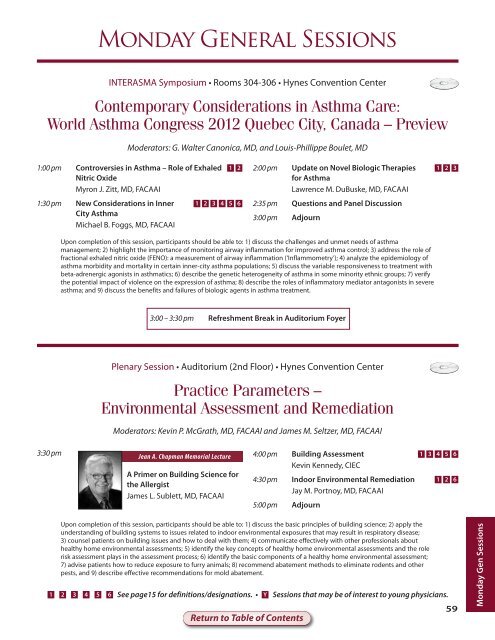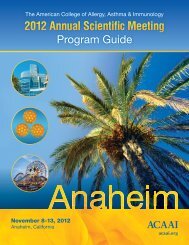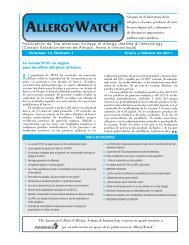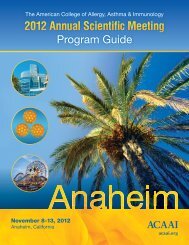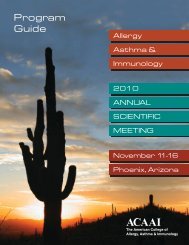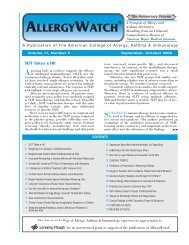Monday Concurrent SessionsBallroom C (3rd Floor) • Hynes Convention CenterSession D – Immunotherapy/Immunizations <strong>and</strong> OtherModerators: Donald N. Leibner, MD, FACAAI <strong>and</strong> John R. Seyerle, MD1:00 pm 57 – A Novel Bispecific Antibody SuppressesDermatophagoides Pteronyssinus 1-Induced<strong>Allergy</strong> in a Mouse ModelA.S. Nayak 1 , P. Bhattacharya 2 , N.A. Nayak 1 ,B.S. Prabhakar* 2 , 1. Normal, IL; 2. Chicago, IL.1:15 pm 58 – The Effect <strong>of</strong> Active Pulmonary Tuberculosis<strong>and</strong> Its Intensive Phase Treatment on the SkinTest Reactivity <strong>of</strong> Atopic Pediatric PatientsSensitized to AeroallergensA.A. Elorde*, M.W. Sumpaico, M.T. Recto,M.R. Castor, J.C. de Leon, Manila, Philippines.1:30 pm 59 – The Changes <strong>of</strong> Specific T Cells Immuno-Response to House Dust Mite(Hdm) in <strong>Asthma</strong>ticChildren Treated with Subcutaneous HDMSpecific ImmunotherapyL. Xiang*, W. Wang, H. Feng, K. Shen, Beijing, China.1:45 pm 60 – Benefit <strong>of</strong> Multiantigen Immunotherapy inClinical PracticeG. Gurka*, W. Vaughan, Arlington, MA.WITHDRAWN2:00 pm 61 – Factors Affecting Adherence to ImportedFire Ant ImmunotherapyS. Stokes* 1 , J.M. Quinn 1 , J. Sacha 2 , K. White 3 , 1. SanAntonio, TX; 2. Travis AFB, CA; 3. Lackl<strong>and</strong> AFB, TX.2:15 pm 62 – The Efficacy <strong>of</strong> a Nasal CorticosteroidCiclesonide for the Treatment <strong>of</strong> Serous OtitisMedia in Atopic ChildrenS. Nsouli* 1 , S. El Sabbah 2 , 1. Danville, CA; 2. Beirut,Lebanon.2:30 pm 63 – Allergen Immunotherapy Practice Patterns:a Worldwide SurveyS. Mithani* 1 , C. Sison 2 , P. Gupta 3 , D. Larenas 4 ,P. Ponda 1 , 1. Great Neck, NY; 2. Manhasset, NY;3. Brooklyn, NY; 4. Mexico City, Mexico.2:45 pm 64 – Anti-Allergic Inflammatory Effects <strong>of</strong>Bacillus Subtilis P-L2 Suppressions <strong>of</strong> Pro-Inflammatory Cytokine Release On Human MastCell Line (HMC-1)Y. Ko*, C.H. Ryu, Jinju, Republic <strong>of</strong> Korea.Upon completion <strong>of</strong> this session, participants should be able to: 57) foresee the use <strong>of</strong> bispecific antibodies for the treatment <strong>of</strong>atopic disorders, a major advancement <strong>of</strong> biotechnology in the field <strong>of</strong> <strong>Allergy</strong> <strong>and</strong> Immunology; 58) describe the hygienehypothesis through the potential relationship <strong>of</strong> tuberculosis <strong>and</strong> its treatment to the wheal size on skin prick test to aeroallergensamong atopic patients <strong>and</strong> consider the possibility <strong>of</strong> using mycobacteria in the treatment <strong>of</strong> atopic diseases; 59) summarize theadvantages, disadvantages, <strong>and</strong> limitations <strong>of</strong> these techniques in clinical practice; 60) recognize the benefit <strong>of</strong> allergy shots withmultiple mixed antigens; 61) recognize that patient adherence to IFA SCIT is problematic; 62) use a pharmacological topical agentthat is efficacious, safe <strong>and</strong> shorten the duration <strong>of</strong> the treatment <strong>of</strong> serous otitis media in atopic children rather than an oralantibiotic given the safety issues with long term use <strong>of</strong> systemic antibiotics; 63) recognize that little consistency exists regardingdose adjustments <strong>and</strong> frequency changes in immunotherapy during peak pollen seasons; <strong>and</strong> 64) review the application <strong>of</strong>Bacillus subtilis for inflammation clinic which is a useful microorganism in Asia but not yet well-known in America.3:00 – 3:30 pm Refreshment Break in Auditorium Foyer58Return to Table <strong>of</strong> Contents
Monday General SessionsINTERASMA Symposium • Rooms 304-306 • Hynes Convention CenterContemporary Considerations in <strong>Asthma</strong> Care:World <strong>Asthma</strong> Congress 2012 Quebec City, Canada – PreviewModerators: G. Walter Canonica, MD, <strong>and</strong> Louis-Phillippe Boulet, MD1:00 pm Controversies in <strong>Asthma</strong> – Role <strong>of</strong> ExhaledNitric OxideMyron J. Zitt, MD, FACAAI122:00 pm Update on Novel Biologic Therapiesfor <strong>Asthma</strong>Lawrence M. DuBuske, MD, FACAAI1231:30 pm New Considerations in InnerCity <strong>Asthma</strong>Michael B. Foggs, MD, FACAAI1234562:35 pm Questions <strong>and</strong> Panel Discussion3:00 pm AdjournUpon completion <strong>of</strong> this session, participants should be able to: 1) discuss the challenges <strong>and</strong> unmet needs <strong>of</strong> asthmamanagement; 2) highlight the importance <strong>of</strong> monitoring airway inflammation for improved asthma control; 3) address the role <strong>of</strong>fractional exhaled nitric oxide (FENO): a measurement <strong>of</strong> airway inflammation (‘Inflammometry’); 4) analyze the epidemiology <strong>of</strong>asthma morbidity <strong>and</strong> mortality in certain inner-city asthma populations; 5) discuss the variable responsiveness to treatment withbeta-adrenergic agonists in asthmatics; 6) describe the genetic heterogeneity <strong>of</strong> asthma in some minority ethnic groups; 7) verifythe potential impact <strong>of</strong> violence on the expression <strong>of</strong> asthma; 8) describe the roles <strong>of</strong> inflammatory mediator antagonists in severeasthma; <strong>and</strong> 9) discuss the benefits <strong>and</strong> failures <strong>of</strong> biologic agents in asthma treatment.3:00 – 3:30 pm Refreshment Break in Auditorium FoyerPlenary Session • Auditorium (2nd Floor) • Hynes Convention CenterPractice Parameters –Environmental Assessment <strong>and</strong> RemediationModerators: Kevin P. McGrath, MD, FACAAI <strong>and</strong> James M. Seltzer, MD, FACAAI3:30 pmJean A. Chapman Memorial LectureA Primer on Building Science forthe AllergistJames L. Sublett, MD, FACAAI4:00 pm Building AssessmentKevin Kennedy, CIEC4:30 pm Indoor Environmental RemediationJay M. Portnoy, MD, FACAAI5:00 pm Adjourn134152661Upon completion <strong>of</strong> this session, participants should be able to: 1) discuss the basic principles <strong>of</strong> building science; 2) apply theunderst<strong>and</strong>ing <strong>of</strong> building systems to issues related to indoor environmental exposures that may result in respiratory disease;3) counsel patients on building issues <strong>and</strong> how to deal with them; 4) communicate effectively with other pr<strong>of</strong>essionals abouthealthy home environmental assessments; 5) identify the key concepts <strong>of</strong> healthy home environmental assessments <strong>and</strong> the rolerisk assessment plays in the assessment process; 6) identify the basic components <strong>of</strong> a healthy home environmental assessment;7) advise patients how to reduce exposure to furry animals; 8) recommend abatement methods to eliminate rodents <strong>and</strong> otherpests, <strong>and</strong> 9) describe effective recommendations for mold abatement.23456See page15 for definitions/designations. • Y Sessions that may be <strong>of</strong> interest to young physicians.Return to Table <strong>of</strong> Contents59Monday Gen Sessions
- Page 3:
WelcomeAmerican College of Allergy,
- Page 8 and 9:
Greetings from the AllianceWelcome
- Page 10 and 11: Corporate SupportersACAAI appreciat
- Page 12 and 13: Special AnnouncementsAdmission by B
- Page 14 and 15: Special AnnouncementsSpeaker Ready
- Page 16 and 17: Education InformationThis activity
- Page 18 and 19: Daily EventsHOURSAll programs held
- Page 20 and 21: Daily EventsHOURSAll programs held
- Page 22 and 23: Daily EventsHOURSAll programs held
- Page 24 and 25: Daily EventsHOURSAll programs held
- Page 26 and 27: WorkshopsAdmission by ticket only
- Page 28 and 29: WorkshopsAdmission by ticket only
- Page 30 and 31: WorkshopsAdmission by ticket only
- Page 32 and 33: WorkshopsAdmission by ticket only
- Page 34 and 35: Friday Literature ReviewRooms 302-3
- Page 36 and 37: Friday ProgramRoom 210 • Hynes Co
- Page 38 and 39: Friday Symposia & House of Delegate
- Page 40 and 41: Friday ProgramAnnual Session and Bu
- Page 42 and 43: Saturday General SessionsOpening Ce
- Page 44 and 45: Saturday General SessionsEAACI Symp
- Page 46 and 47: Meet the Professor BreakfastsHynes
- Page 48 and 49: Sunday General SessionsPlenary Sess
- Page 50 and 51: Sunday Concurrent SessionsBallroom
- Page 52 and 53: Sunday Concurrent SessionsBallroom
- Page 54 and 55: Monday General SessionsBreakfast Sy
- Page 56 and 57: Monday General SessionsPlenary Sess
- Page 58 and 59: Monday Concurrent SessionsBallroom
- Page 62 and 63: Annual Business MeetingGrand Ballro
- Page 64 and 65: Advanced Practice Health Care Provi
- Page 66 and 67: Office Administrators CourseRoom 31
- Page 68 and 69: Allied Health Professionals CourseR
- Page 70 and 71: Allied Health Professionals CourseR
- Page 72 and 73: Poster Session12:30 - 1:30 pm, Satu
- Page 74 and 75: Poster Session7212:30 - 1:30 pm, Sa
- Page 76 and 77: Poster Session12:30 - 1:30 pm, Satu
- Page 78 and 79: Poster SessionP95P96P97WITHDRAWNP98
- Page 80 and 81: Poster Session7812:30 - 1:30 pm, Sa
- Page 82 and 83: Poster Session12:30 - 1:30 pm, Satu
- Page 84 and 85: Poster Session12:30 - 1:30 pm, Satu
- Page 86 and 87: Poster Session12:30 - 1:30 pm, Satu
- Page 88 and 89: Poster Session8612:30 - 1:30 pm, Sa
- Page 90 and 91: Poster Session12:30 - 1:30 pm, Satu
- Page 92 and 93: Poster Session12:30 - 1:30 pm, Satu
- Page 94 and 95: Poster Session9212:30 - 1:30 pm, Sa
- Page 96 and 97: Poster Session12:30 - 1:30 pm, Satu
- Page 98 and 99: Poster Session12:30 - 1:30 pm, Satu
- Page 100 and 101: Plenary & Symposia FacultyGary N. G
- Page 102 and 103: Faculty IndexNelson, Michael R. . .
- Page 104 and 105: DisclosuresThomas B. Casale, MD, FA
- Page 106 and 107: DisclosuresLynda C. Schneider, MD,
- Page 108 and 109: DisclosuresChallenging Cases for th
- Page 110 and 111:
Special EventsACAAI Awards Ceremony
- Page 112 and 113:
Tribute to Our Past PresidentsPast
- Page 114 and 115:
ACAAI FoundationACAAI Foundation
- Page 116 and 117:
Fellows-in-TrainingAll Fellows-in-T
- Page 118 and 119:
Travel Grant RecipientsThanks to th
- Page 120 and 121:
Travel Grant RecipientsThanks to th
- Page 122 and 123:
Travel Grant RecipientsThanks to th
- Page 124 and 125:
Product TheaterThese are commercial
- Page 126 and 127:
ExhibitsHalls C & D • Hynes Conve
- Page 128 and 129:
ExhibitsHalls C & D • Hynes Conve
- Page 130 and 131:
ExhibitsHalls C & D • Hynes Conve
- Page 132 and 133:
ExhibitsHalls C & D • Hynes Conve
- Page 134 and 135:
ExhibitsHalls C & D • Hynes Conve
- Page 136 and 137:
ExhibitsHalls C & D • Hynes Conve
- Page 138 and 139:
ExhibitsHalls C & D • Hynes Conve
- Page 140 and 141:
ExhibitsHalls C & D • Hynes Conve
- Page 142 and 143:
Index of ExhibitsHalls C & D • Hy
- Page 144 and 145:
Index of ExhibitorsHalls C & D •
- Page 146 and 147:
Exhibit Hall MapRHC133513331331Alle
- Page 148 and 149:
Hynes Convention CenterLevel 2WSout
- Page 150 and 151:
Sheraton Boston Hotel2nd Floor - Pl
- Page 153 and 154:
BRIEF SUMMARY OF FULL PRESCRIBING I
- Page 155 and 156:
Visit us at Booth #419For adolescen


